The Ten Essentials: An Annotated List
By far, the best known outdoor equipment list is the so called list of Ten Essentials. The list was first suggested in the 1930s in an article which appeared in the newsletter of the Mountaineers, a Seattle-based outdoor club. Since then it has been reprinted in various forms and is used often by outdoor educators as a teaching tool.
The original ten items, along with helpful notes, are listed below. Even though the Ten Essentials List is revered by many in the outdoor field, it shouldn't be taken as gospel. It is a good starting point, but you should add to the list depending on circumstances: where you are going and what you will be doing. Suggestions for additional items are included at the end of the list.
◻Matches. (Use "Strike-anywhere" matches. Whatever you do, don't use "Strike-on-box' matches." It is impossible to light "Strike-on-box" matches on anything other than the special striker strip on the box. If you don't have the match 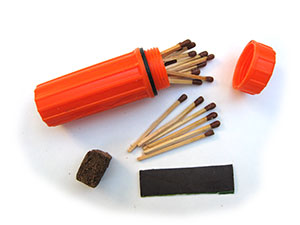 box or if the box gets wet, you are in big trouble. Try it out for yourself, and you'll be amazed. They simply won't light on anything else.
box or if the box gets wet, you are in big trouble. Try it out for yourself, and you'll be amazed. They simply won't light on anything else.
Be very careful when shopping for matches. It's easy to get the two different types of matches mixed up at the store. The boxes look the same. Always double-check and make sure you buy the right matches.
Once you're sure that you have the right matches, place the matches in a waterproof case--small plastic waterproof match containers sold at sporting goods stores work fine--and include a striker. A piece of emery board makes a good striker.
In very wet conditions, you'll want to have a dry striker along with your matches. When you need a fire, you don't want to mess around trying to light matches on wet rocks. Matches, which weigh nothing and easily fit in your pocket, are one of your most important survival tools. Not only does fire allow you to survive a cold, miserable night, but it is an important moral booster as well.
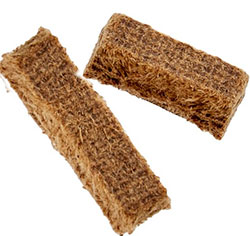 ◻Fire Starter. Always include fire starter with matches. Always. There are times when even the best woodsman or woodswoman will not be able to make a fire without it. Fire starter assures that you can get fire going quickly, no matter how bad the conditions.
◻Fire Starter. Always include fire starter with matches. Always. There are times when even the best woodsman or woodswoman will not be able to make a fire without it. Fire starter assures that you can get fire going quickly, no matter how bad the conditions.
Place some fire starter in your pack, but also put a small chunk of fire starter along with your matches and a striker in a waterproof case. Carry the case in your pocket. Never put your waterproof match case in your pack. If you do and if for some reason, you get separated from your pack, you're in trouble.)
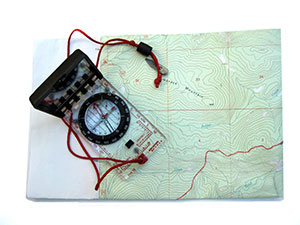 ◻Map. (Many people who have been rescued could have easily gotten themselves out of trouble by simply having a good map along.)
◻Map. (Many people who have been rescued could have easily gotten themselves out of trouble by simply having a good map along.)
◻Compass. (Even if you carry a GPS device, you still need a compass. Although, GPS units provide a reasonably accurate fix of your location, they do not provide accurate bearings. If you know how to following a compass bearing, you can guide yourself out of thickly forested areas, featureless winter landscapes, foggy sagebrush areas, etc.)
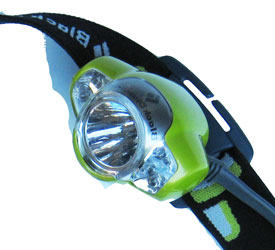 ◻Flashlight, Extra Batteries and Bulb. (A flashlight--or better yet, a headlight--is another one of those tools, like a map, that is simple and cheap insurance. Should night overtake you, it gives you the ability to find your way back to the trailhead.)
◻Flashlight, Extra Batteries and Bulb. (A flashlight--or better yet, a headlight--is another one of those tools, like a map, that is simple and cheap insurance. Should night overtake you, it gives you the ability to find your way back to the trailhead.)
◻Extra Food. (Having extra food is critical in emergency situations. It helps ward off hypothermia in cold, wet weather, and it keeps you thinking clearly in a crisis.)
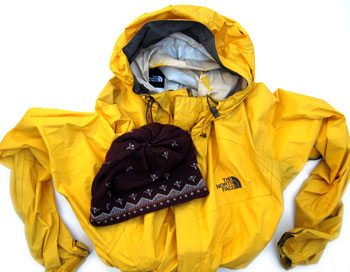 ◻Extra Clothing. (Even if it's a sunny day and you're on a short day hike, you should carry at least a rain jacket. It keeps you dry and also serves as wind protection. A good hat (wool or pile) stocking hat is also high on the list of extra clothing since a large amount of body heat is lost through the head and neck area. When deciding what to take, stay away from cotton which is worthless when wet.)
◻Extra Clothing. (Even if it's a sunny day and you're on a short day hike, you should carry at least a rain jacket. It keeps you dry and also serves as wind protection. A good hat (wool or pile) stocking hat is also high on the list of extra clothing since a large amount of body heat is lost through the head and neck area. When deciding what to take, stay away from cotton which is worthless when wet.)
◻Sunglasses. (Good sunglasses are particularly important when you are in snow country. Snow blindness can completely disable an individual.)
◻First Aid Kit. (Be prepared for emergencies. Carry basic first aid supplies such as sterile gauze and pads, bandaids, moleskin, etc. See lightweight first aid kit for ideas.)
◻Pocket Knife. (With a pocket knife--a multi purpose Swiss Army knife is ideal--you can make field repairs, shave branches to make kindling, punch holes to repair a tarp, cut nylon cord, etc.)
Other Essentials
Here's some other important items that you'll want to consider in addition to those listed above.
Shelter. The Ten Essentials' list has one glaring omission. It lacks the materials to build an emergency shelter. When all is considered, the best way of surviving wet or snowy nights is have some type of roof over your head and a dry floor under you.
One of the best shelter options is a combination of a lightweight nylon poncho, nylon cord and a lightweight space blanket. The poncho can be tied to trees or placed over a rudimentary snow shelter to keep out wind and weather--and in a pinch it doubles as a rain jacket.
Use a nylon poncho or tarp. Avoid plastic ponchos and tarps. They rip easily and become brittle in cold weather. For a dry floor underneath you, a lightweight space blanket is a good choice. They are inexpensive, light, and aren't much larger than the size of a bar of soap. Since such lightweight space blankets, however, can tear easily, they are best used as a floor and not depended upon as a tarp over your head.
Desert Travel Considerations. Don't forget one or more containers of water (an important item for any outdoor travel) and a piece of plastic for making a solar still.
Winter Travel Considerations. For winter travel, make sure you have adequate extra clothing. You'll also want to carry enough repair supplies to be able to fix a broken snowshoe or ski. A headlight is doubly important in the winter since days are short and night comes quickly.
It's hard to get to water in the winter--lakes are frozen and streams are under a deep layer of snow--and you'll need a metal cup to use for melting snow.
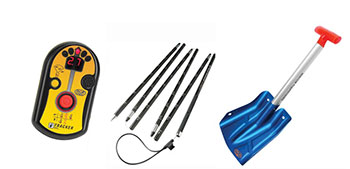 A portable shovel is an important winter survival tool. With one you can dig snow caves or snow trenches in which you can survive a bitter, cold night. Moreover, in avalanche terrain, a shovel is a must. It is nearly impossible to dig someone out of an avalanche without a shovel. Lastly, in avalanche country, always carry an avalanche transceiver and proble along with your shovel.
A portable shovel is an important winter survival tool. With one you can dig snow caves or snow trenches in which you can survive a bitter, cold night. Moreover, in avalanche terrain, a shovel is a must. It is nearly impossible to dig someone out of an avalanche without a shovel. Lastly, in avalanche country, always carry an avalanche transceiver and proble along with your shovel.
Walk-up Mountaineering. If you enjoy climbing mountains without using technical equipment, it is still good practice to carry at least 50 feet of lightweight rope for emergencies.
Lakes and Rivers. For water related activities, a life jacket is a must. Hypothermia is always a concern and you'll want plenty of high energy food, rain gear and synthetic clothing. Carry a throw rope rather than a coiled rope. They are far easier to use and are less apt to get tangled. And, of course, no self respecting river rat ever leaves home without a roll of duct tape.
[END]
